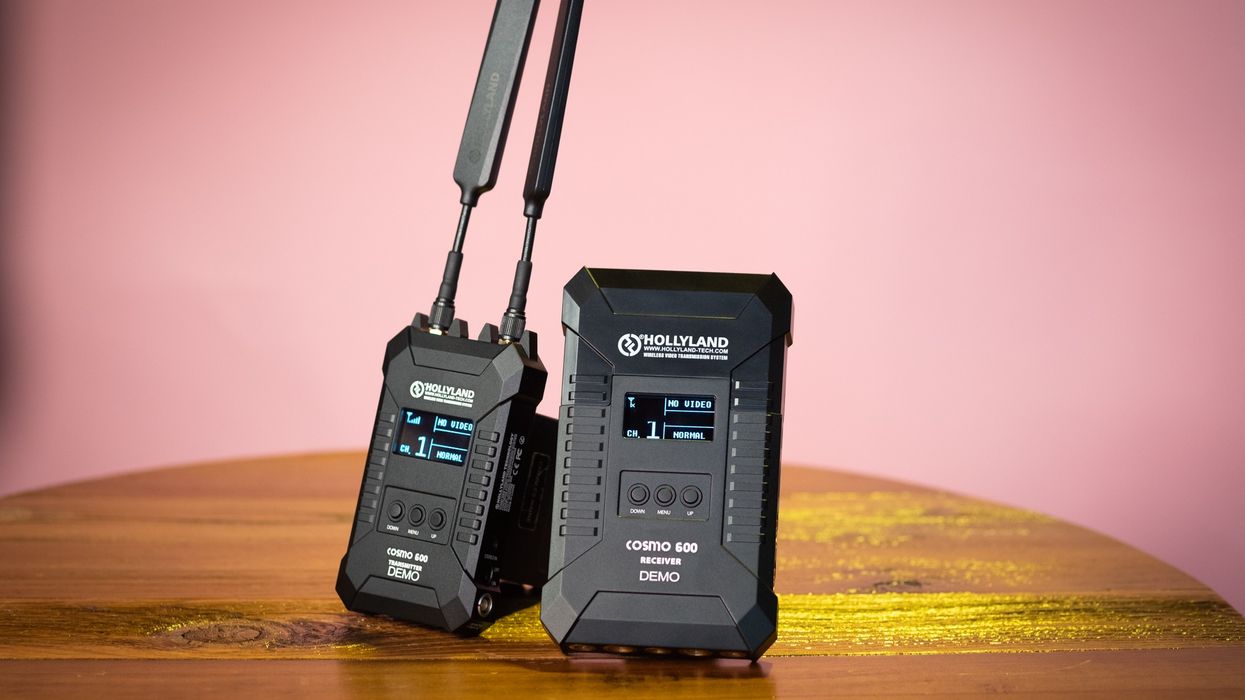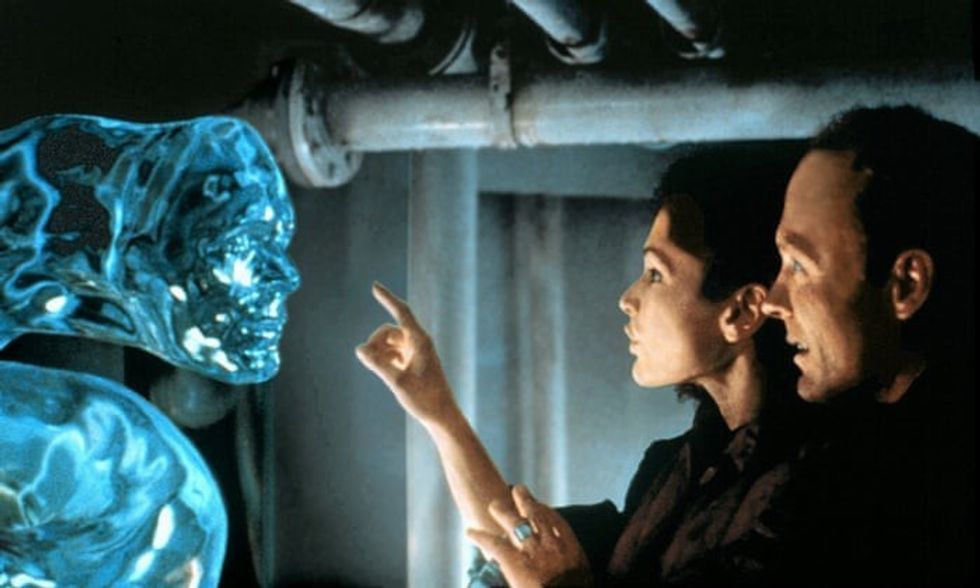Cosmo 600: The Zero-Latency Wireless Kit for Low-Budget Filmmakers
The wireless video market is heating up quite a bit this year, and Hollyland offers an interesting combination of features for a very accessible price point.

The Cosmo 600 and it's big brother the Cosmo 2000 are zero-delay wireless kits that are designed to let your camera roam free while delivering a robust 1080 video signal back to your video village.
Hollyland builds the rest of the unit around the same WHDI chip that is practically an industry-standard. As is also standard throughout the industry, the units only play with other Cosmo units, but that is true of all the systems (even though ARRI uses Amimon chips, and so does Teradek, you can't pair a Teradek with an ARRI wireless video setup, for instance).
The compelling case for Hollyland is an entry-level price point ($1700 or so) that comes WITH SDI. You can get cheaper solutions without SDI, but as filmmakers, we always at least want the option of an SDI connector, and Hollyland lets you get into that in an affordable fashion.
What is it?
The Cosmo 600 unit is a 1 lb. receiver (that you could mount to your monitor or elsewhere in video village), along with a 9 oz. transmitter that you mount to your camera. Both are powered by Lemo connectors, but in the kit we tested and are linking to, they come with built-in Sony L-mount battery plates.
If you don't own a host of these batteries yet, you soon will, and most filmmakers have multiple chargers and batteries already ready in this format. Monitors use it, some lights use it, it's really practically an industry standard now, even though we don't know if Sony even makes a camera anymore that takes it.

This is particularly appealing if you are working on a camera that doesn't offer power output. A larger camera like the RED or Alexa line will have power outputs so you can use a single battery to power up your camera and accessories like wireless video via pricy Lemo cables.
But shooting on an EVA1, C200, or Blackmagic Pocket Cinema 4K leaves you without power output, so you have to power your wireless video another way. Almost all wireless video solutions offer battery plate options but they generally cost extra and it's nice that the Cosmo builds them in practically by default.
Does it work?
Yep.
Plug in two Sony batteries, stick an SDI signal in the transmitter, and it connects to the receiver. It's really that easy. Since it doesn't encrypt (discussed below), you simply set the channel on the transmitter and the channel on the receiver to match, and it works.
Like all of these devices, it's important to remember "line of sight" in the specs. It has a 600' "line of sight," meaning outside in a field with no obstructions where you can see the units. You will get less than 600' working on a stage. Walk to the next stage over, with the massive soundproof walls in between, and you are almost definitely going to lose signal. This is true of all wireless video, but something worth reminding potential users.
One thing we appreciated was the recessed SDI connectors. Even with our large hands it was relatively easy to get the cable in and out of the unit, and by being recessed we felt like there was some level of protection from the hits and stresses of life on set that was provided. One thing it doesn't do is cross-convert within the transmitter. There are both an HDMI input and an SDI loop-out, but the SDI loop-out ONLY works for the SDI in.
This is useful if your camera only has one SDI out, and you want to run it to the transmitter, then run it on to another monitor on the camera. But if you have an HDMI camera, for instance, and run HDMI to that transmitter, the SDI output doesn't put out a signal.
The OLED screens don't give out a ton of info but do give you a small signal strength indicator, and you can hold down the menu button for more signal strength and firmware info, which is appreciated. Like most wireless solutions, you need to hook up the monitor or connect an app for this information, but having a screen that reads your signal strength will sometimes make life easier, especially in situations where you might be deciding on where to put video village (you want it to get strong signal) before pulling out the monitors and setting it all up.
There are also multiple 1/4-20 and 5/8" threaded mounting points on the bottom of the units which should make for flexible placement. While 5/8" seems like overkill on the transmitter (most mounting arms will be 1/4-20), the 5/8" will definitely be useful on the receiver side.
What are its limitations?
One of the big limitations to know about is that, right now, while the Cosmo line supports encryption, it only supports it for the Cosmo 2000, which comes in at the very reasonable price of around $4000. We don't know if the Cosmo 600 will eventually support it, but you can upgrade the firmware and we hope this feature rolls out in the future.
Right now, anybody with another Cosmo 600 receiver can switch to the same channel and get signal. For many, many users, the lack of encryption isn't a problem at all for the 600 unit. If you aren't working on something with locked-down IP (we always say "the new Marvel movie" as our example of a movie where sneaky bad actors might try to get access to your video stream, but any big movie you worry about this) you aren't going to have a problem. If you are worried about others snooping on your video feed, you will indeed want to upgrade to something encrypted.
Without encryption, any other Cosmo receiver can simply switch to the transmitting channel of the transmitter and receive a signal. If you are indeed shooting that big Marvel movie, someone could see a BTS photo, identify the wireless transmitter you are using, and then go buy a receiver to watch what is being shot. On big movies that is a concern. This is very unlikely to happen on your indie movie. It's frankly just not a concern on probably any project we've ever worked on.
The bigger limitation to be aware of, and this is industry-wide, is that brands only play with each other. You'll want to buy more Cosmo receivers if you want a monitor for the director and a monitor for the client and a monitor for the DP. A Teradek receiver won't receive a signal from a Cosmo transmitter, for instance. Right now they are only selling these in a transmitter/receiver pair, though we suspect separate receivers will be coming along soon.
Conclusion
If you are looking to dip your toe into adding wireless video to your shoots, the Cosmo is absolutely worth a look, coming in roughly 30% cheaper than comparable units at $1700. We really like that it offers both SDI and HDMI at the price point where it lands; for the same price competitors offer HDMI-only solutions, but nothing that has both. We like that it includes L plates and a wall plug adapter at that price, and in general, gets up and running so quickly.
If you are in a smaller market or tend to work on single-camera shoots a lot, most of the limitations of the platform will never bother you, and this could be a great options for saving money when putting together a wireless video package if you are buying your first stabilizer and need an affordable wireless video solution, for instance. You should just be conscious, as you make this choice, that if you are a freelancer in a big market, the system won't be compatible with others and you might run into DIT's who won't be able to receive the signal this sends. Of course, those DITs probably have transmitters of their own that they will strap to the camera.
Tech Specs
Transmitter
- Transmission Range 600' / 183 m Line-of-Sight
- Latency<1 ms
- 1 x HDMI Type A Input, 1 x 3G/HD/SD-SDI Input, 1 x 3G/HD/SD-SDI Loop-Through Out
- Resolution: 1080p: 60/59.94/50/30/29.94/25/24/23.98, 1080i: 60/59.94/50
- Supported Audio1 x 3.5 mm Stereo Input, Embedded 2-Channel 24-Bit/48 kHz
- Frequency 5.1-5.9 GHz
- ModulationOFDM 16QAM
- Transmission Power 17 dBm Max
- Bandwidth 40 MHz
- Encryption AES-128 Encryption
- Display OLED
- Firmware Upgradable Mini-USB Port
- Battery Plate L-Series
- Power Input Connection 4-Pin LEMO, Female
- Power Input 7-36 VDC
- Power Consumption<6 W
- Operating Temperature32 to 104°F / 0 to 40°C
- Storage TemperatureNot Specified by Manufacturer
- 5 x 2.75 x 1" / 12.7 x 7 x 2.5 cm (Not Including Antennas)
- 9.2 oz / 260 g
Receiver
- 1 x HDMI Type A Output 2 x 3G/HD/SD-SDI
- AntennaBuilt In
- Battery PlateL-Series
- Power Input Connection4 -Pin LEMO, Female
- Power Input 7-36 VDC
- Power Consumption <8 W
- Operating Temperature 32 to 104°F / 0 to 40°C
- 6.3 x 3.7 x 1" / 15.9 x 9.4 x 2.5 cm
- 1 lb / 460 g
The Cosmo 600 is available now for $1700.





















